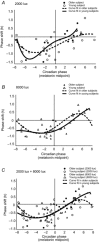Phase-shifting response to light in older adults
- PMID: 24144880
- PMCID: PMC3903359
- DOI: 10.1113/jphysiol.2013.262899
Phase-shifting response to light in older adults
Abstract
Age-related changes in circadian rhythms may contribute to the sleep disruption observed in older adults. A reduction in responsiveness to photic stimuli in the circadian timing system has been hypothesized as a possible reason for the advanced circadian phase in older adults. This project compared phase-shifting responses to 2 h of broad-spectrum white light at moderate and high intensities in younger and older adults. Subjects included 29 healthy young (25.1 ± 4.1 years; male to female ratio: 8: 21) and 16 healthy older (66.5 ± 6.0 years; male to female ratio: 5: 11) subjects, who participated in two 4-night and 3-day laboratory stays, separated by at least 3 weeks. Subjects were randomly assigned to one of three different time-points, 8 h before (-8), 3 h before (-3) or 3 h after (+3) the core body temperature minimum (CBTmin) measured on the baseline night. For each condition, subjects were exposed in a randomized order to 2 h light pulses of two intensities (2000 lux and 8000 lux) during the two different laboratory stays. Phase shifts were analysed according to the time of melatonin midpoint on the nights before and after light exposure. Older subjects in this study showed an earlier baseline phase and lower amplitude of melatonin rhythm compared to younger subjects, but there was no evidence of age-related changes in the magnitude or direction of phase shifts of melatonin midpoint in response to 2 h of light at either 2000 lux or 8000 lux. These results indicate that the acute phase-shifting response to moderate- or high-intensity broad spectrum light is not significantly affected by age.
Figures






References
-
- Ancoli-Israel S, Klauber MR, Jones DW, Kripke DF, Martin J, Mason W, Pat-Horenczyk R, Fell R. Variations in circadian rhythms of activity, sleep, and light exposure related to dementia in nursing-home patients. Sleep. 1997;20:18–23. - PubMed
-
- Benloucif S, Guico MJ, Reid KJ, Wolfe LF, L’Hermite-Baleriaux M, Zee PC. Stability of melatonin and temperature as circadian phase markers and their relation to sleep times in humans. J Biol Rhythms. 2005;20:178–188. - PubMed
-
- Benloucif S, Masana MI, Dubocovich ML. Responsiveness to melatonin and its receptor expression in the aging circadian clock of mice. Am J Physiol-Reg I. 1997;273:R1855–R1860. - PubMed
Publication types
MeSH terms
Substances
Grants and funding
LinkOut - more resources
Full Text Sources
Other Literature Sources

